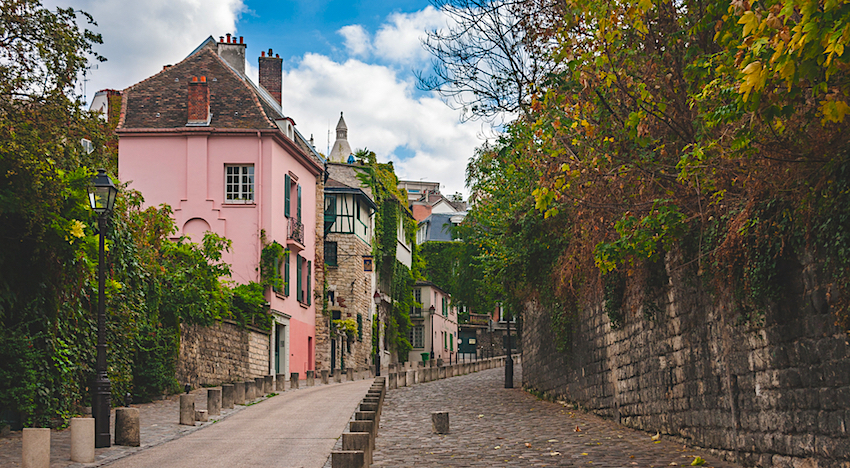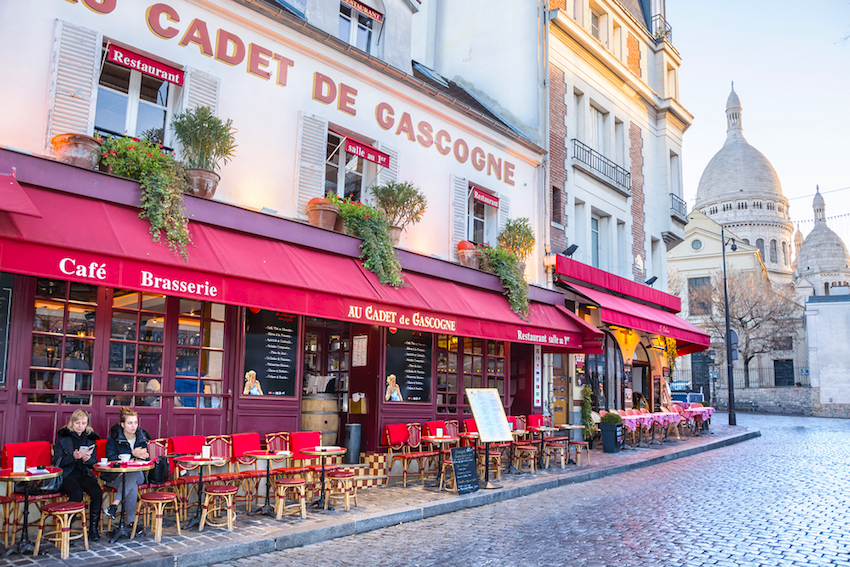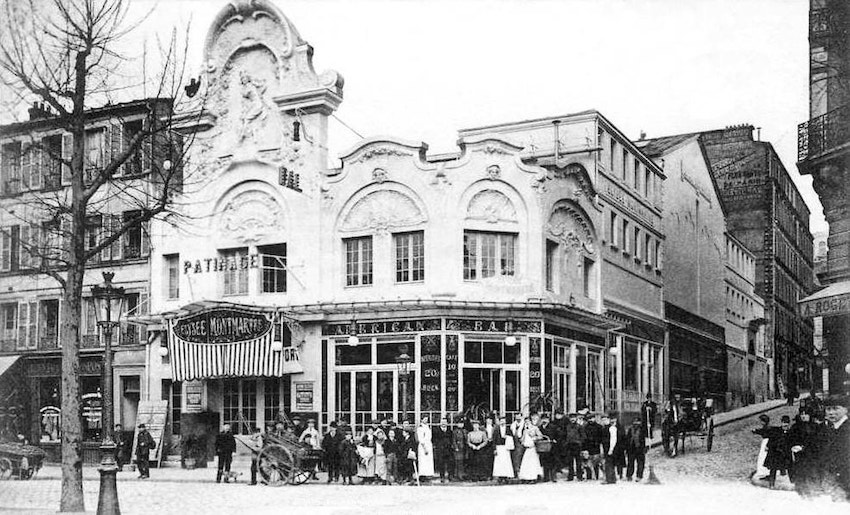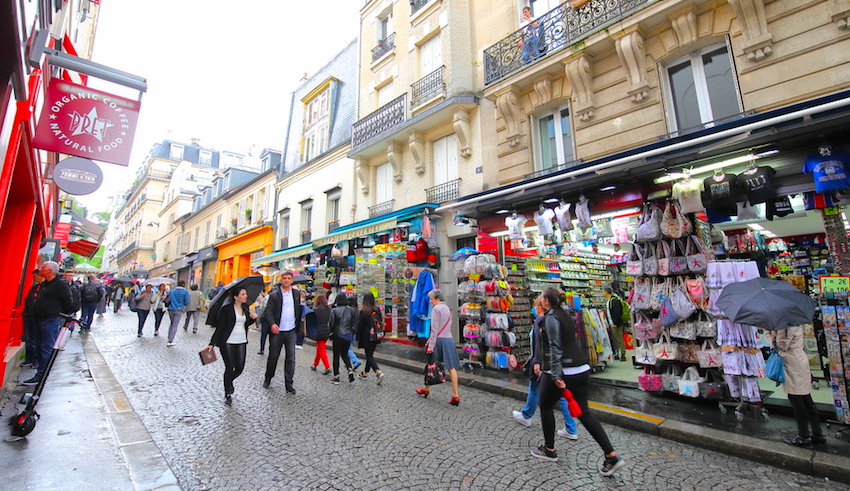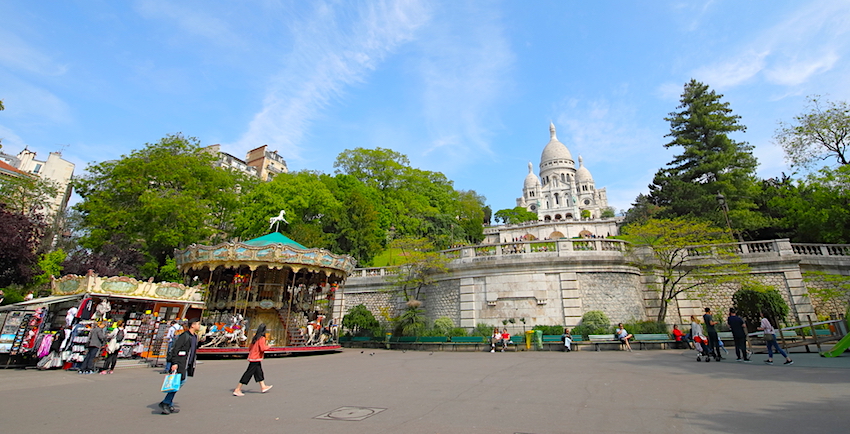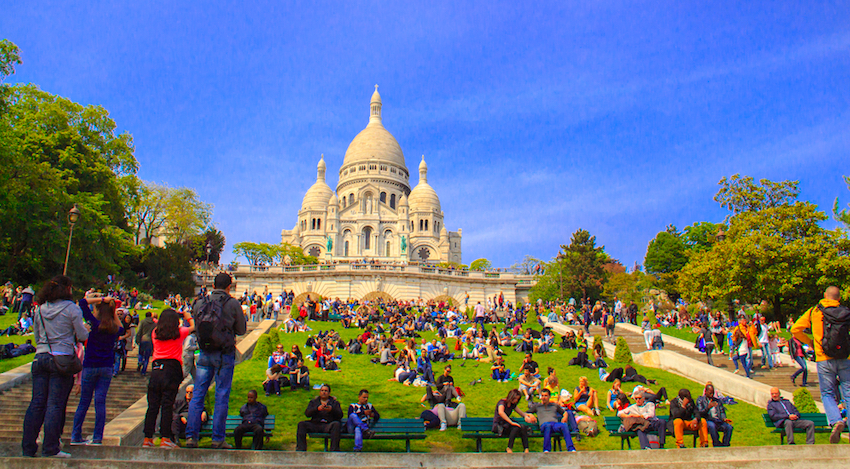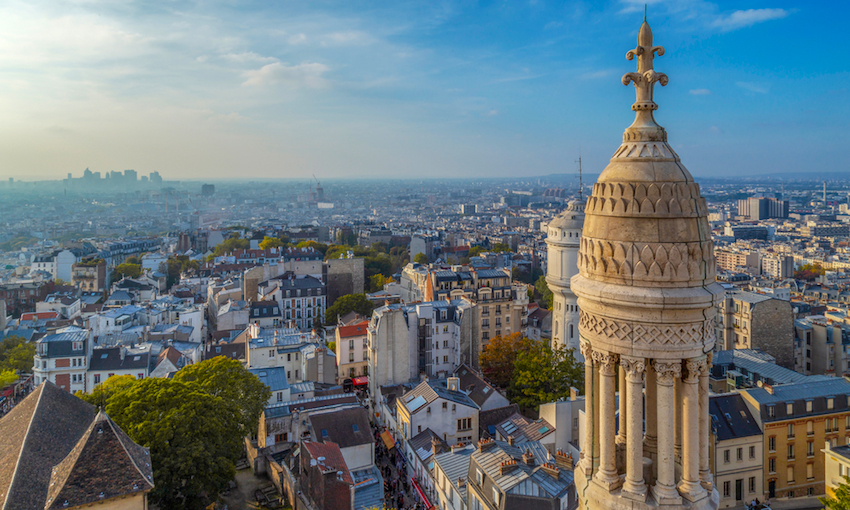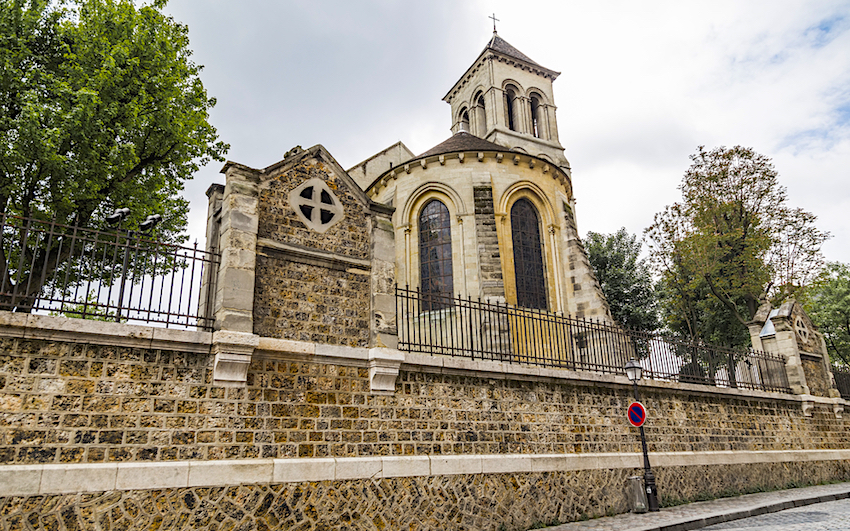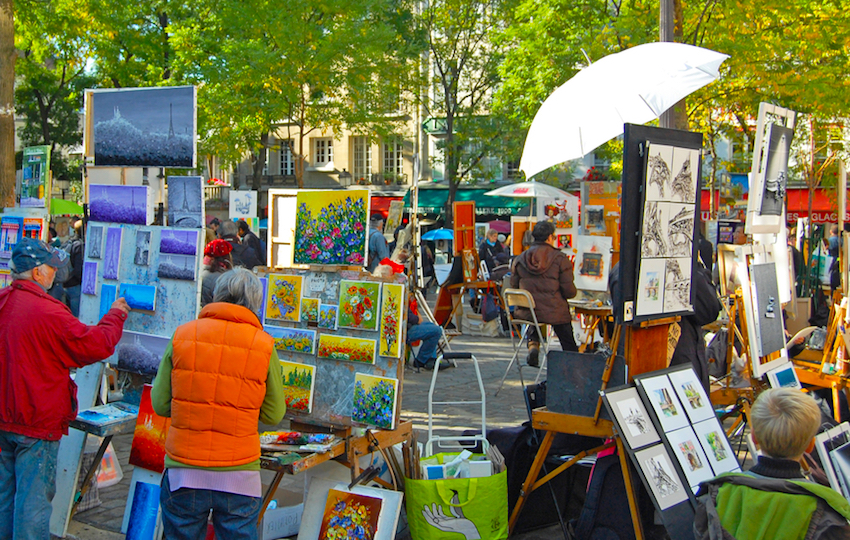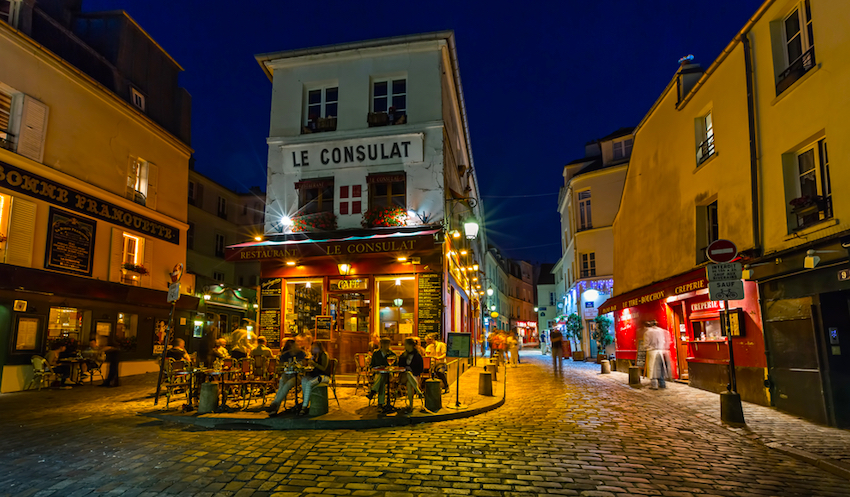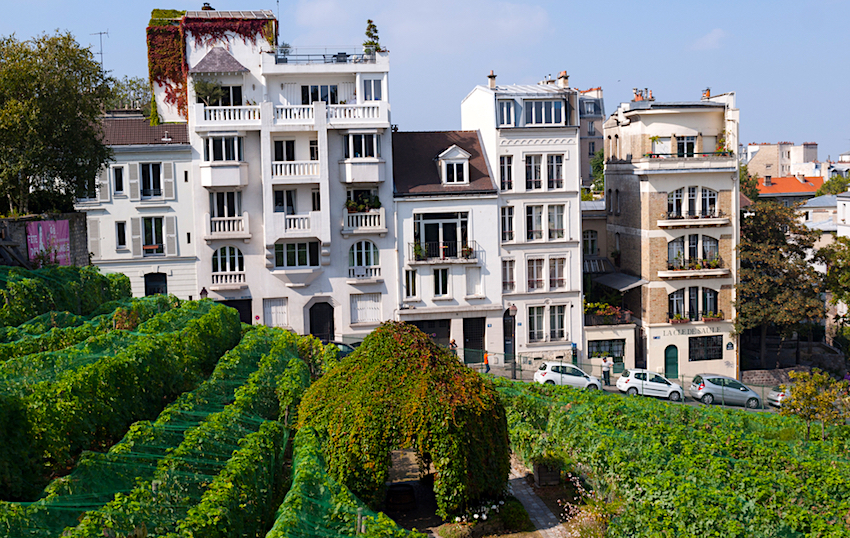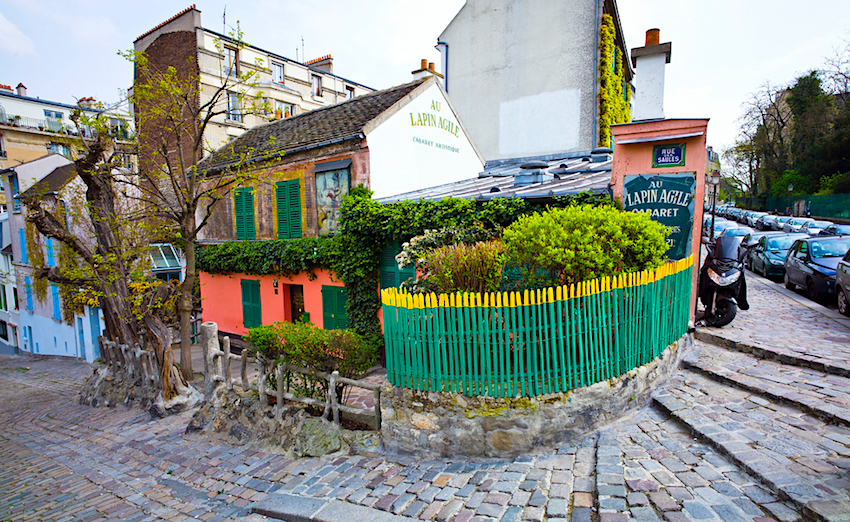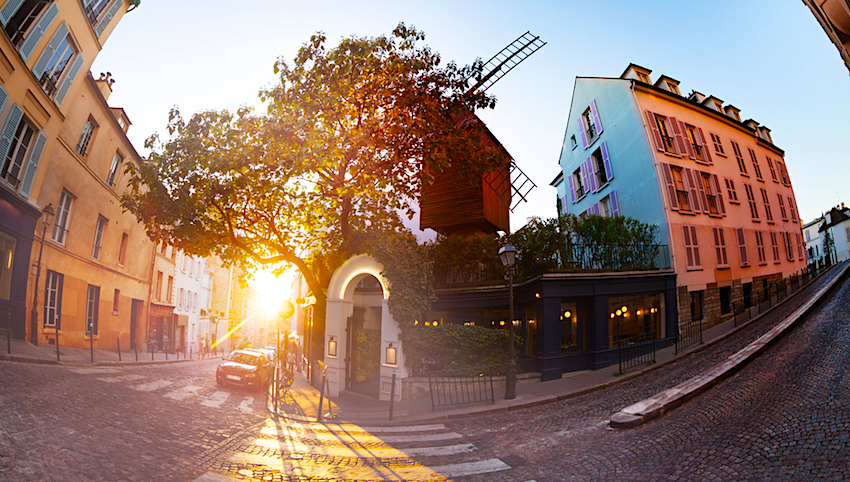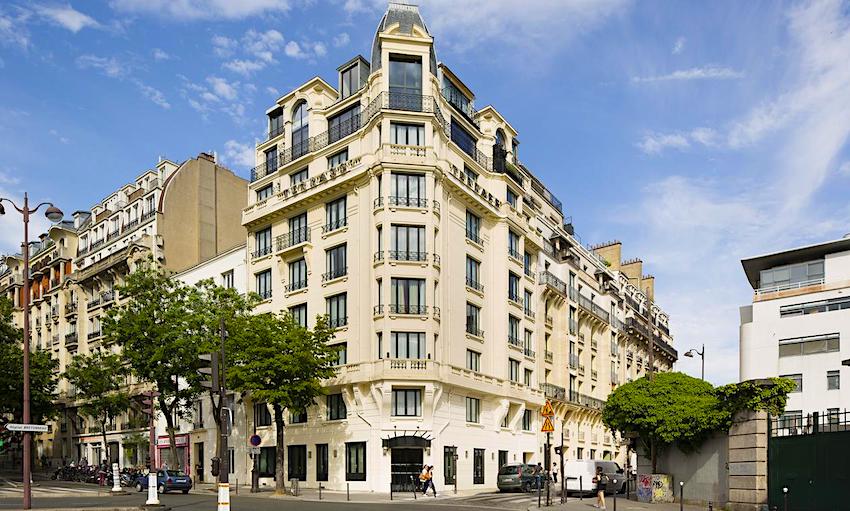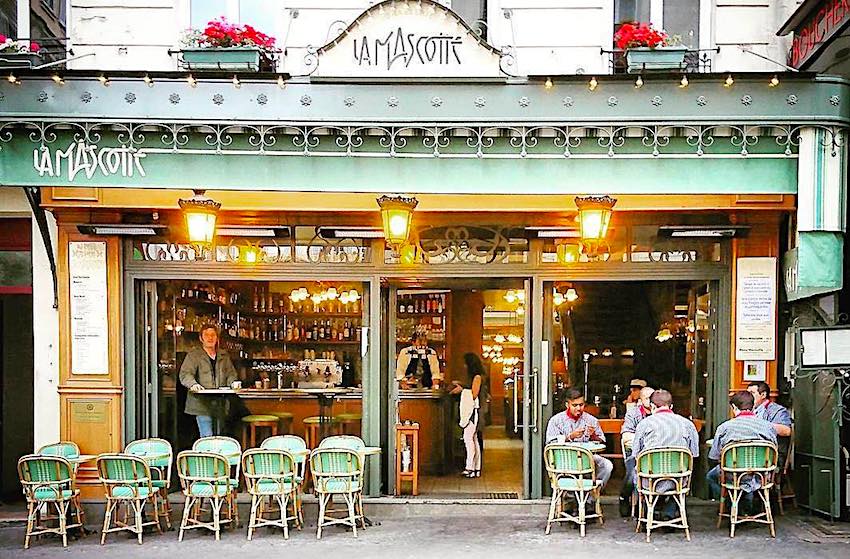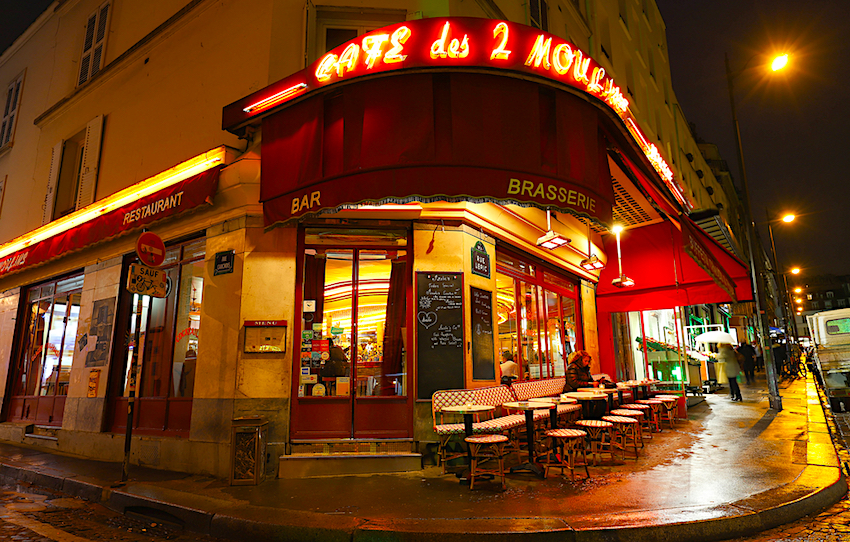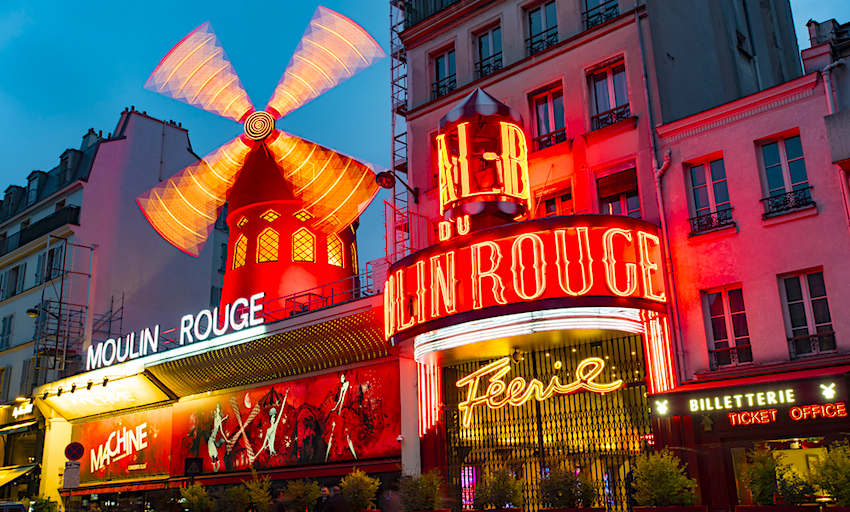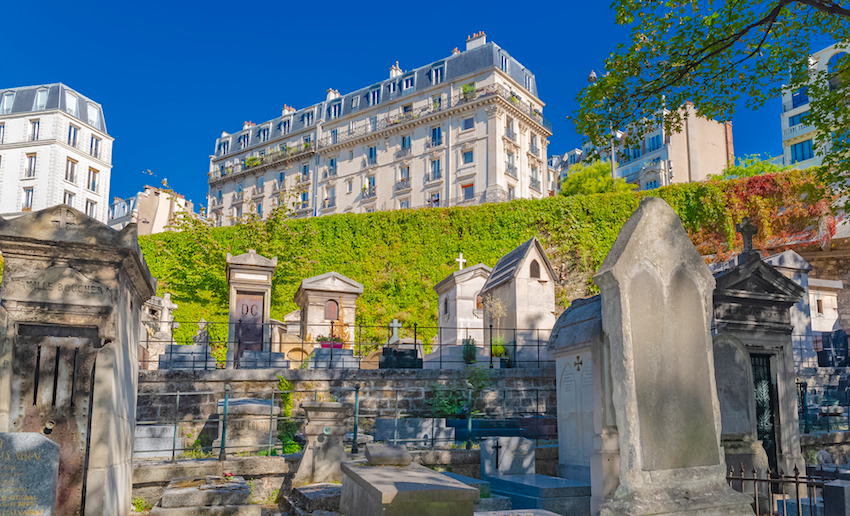Montmartre
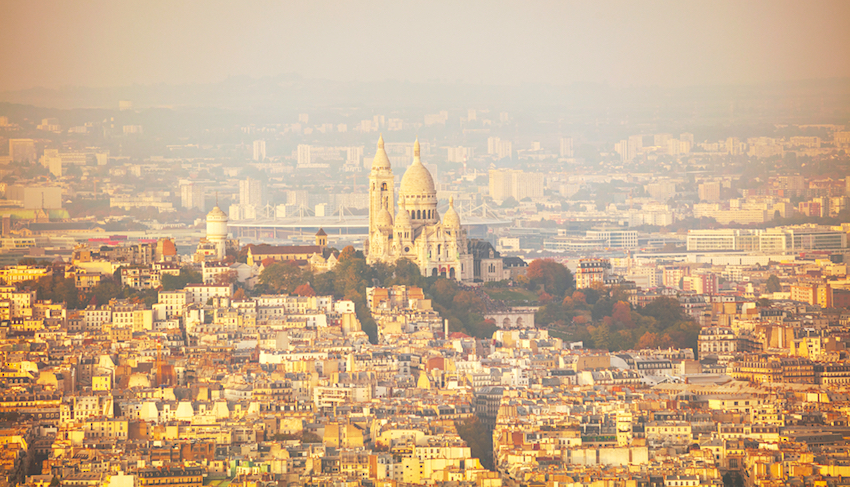
|
Montmartre is talked about by Parisians the way New Yorkers talk about the Village: It's not what it used to be, It's like Disneyland, the artists can't afford to live here anymore, too many tourists etc. There is some truth to these opinions, but there are two ways of approaching this incredibly unique village within the metropolis. The first is to follow the herd instinct and stampede your way up the famous hill, take a picture of yourself on the steps of the basilica, buy an overpriced crepe at the Place du Tertre, get conned into having your portrait sketched, and walk back down clutching newly bought key-rings, postcards, gaudy T-shirts feeling a little mystified about what all the fuss is about. |
|
The second method is to keep a map in your pocket (just in case) and try to lose yourself in the steep and cobbled streets of one of the most historic and interesting neighborhoods in Paris. Remember that the Basilica of Sacre-Coeur (the big white church) sits on the crest of the hill, so as long as you are heading uphill there is little possibility of being lost for long. At the bottom of the hill is the Boulevard de Clichy which is lined with bars, kebab shops, and more sex shops and peep-shows than you can possibly pretend you are not looking at. If you think of a triangle, consider the base of it to be the section of Blvd. de Clichy and Blvd. de Rochechouart between the metro stations Blanche and Anvers. The tip of the triangle would be the Basilica of Sacre-Coeur. The area between these three points is roughly the area of interest. |
|
You can begin your walk at any point along the base of the hill, or take the metro to Abbesses station and step out into the heart of Montmartre. Because all the great poets have told us the journey is more important than the destination, I recommend you start at metro Blanche (Moulin Rouge) or metro Anvers and gradually enter the "village". This will make it feel more like a pilgrimage toward the place that nurtured most of the great artists and writers living in France this past century. If you are handicapped do not be deterred. While cobblestone streets and steps of Montmartre present a problem, there is a small white "mini-train" which looks like a kids ride but will drive up the hill and wind through the narrow alleys giving you a very good sense of the neighborhood without the hassle of struggling with crutches or a wheelchair. This is also recommended for families with children. The little bus can trick the children into thinking they are having a good time, and can be used as a justification for the agony they will endure at the table of another long dinner at a restaurant later. For those of you who are fit and able, over age 9, and childless, sitting in this train while you could be walking is an embarrassment you must reflect upon in the deep recesses of your soul. If you are a straight male in this category, you lose any chance you might have had with a French women if you are sighted riding. |
|
Exiting the Anvers metro station you will notice a marked change in the environment if you are used to the left bank scene. The crowd here is edgier and faster, neon signs flash, pimps lean in doorways, sex shops sell everything you had never thought of and countless nationalities mix on the crowded sidewalks. While Montmarte is gentrified and somewhat "sanitized" these days, the neighboring areas are certainly not. Barbes-Rochechouart to the east can be a little rough at night, so don't go wandering there alone with your camera and guidebooks at night. In the daytime it is a wonderful place to buy anything from socks to television in massive budget shops such as Tatti for household supplies, and Darty for electronics. The streets are also lined with stalls selling towels, underwear, sheets, linens, etc. for ridiculously cheap prices. If you are an arriving poor student in Paris and need supplies, go there! Just watch your wallet--- the bustling street market is a great place to have it lifted. Just across the street you will notice a beautiful building --- the Elysees Montmartre Theatre. It is said to be the oldest can-can dance theatre in Paris, and is obviously underrated and overshadowed because of the famous Moulin Rouge at the other end of the street. It opened in 1807 but it burned down in 2011 and was rebuilt and reopened in 2016 and is now a concert venue and restaurant. See their website |
|
You will notice throngs of people in the little Rue de Steinkerque. Follow them. The street has recently been infected by T-shirt shops and trinket peddlers, but the two Sympa stores with big red signs are an excellent place to find cheap clothing, sometimes brand names that are either irregular or just fell off the back of some truck. Arrive early on Saturday morning and you will be amazed to see trucks pull up and dump enormous cardboard boxes onto the sidewalk. Then the workers run out with boxcutters, split the tape seals, and literally dump piles of jeans or sweaters made by Naff Naff or Bennetton or Esprit onto huge wooden sidewalk bins. Now the ladies lined up on the opposite sidewalk like Olympic sprinters jump the gun and swarm the piles. The sight alone is remarkable. Elbows fly, hands spin through sweaters, banknotes appear and disappear, clothes sail over shoulders, arms grow heavy under mountains of cloth--- it's like watching seagulls on a shrimp boat. It's western civilization at its finest! On this street you will also find interesting fabric stores as well as Columbia Coffee, one of the rare take-out coffee shops in Paris for those hardcore New Yorkers who need their fix on the go. I actually appreciate the concept of "to-go" coffee, as do others who don't have three hours to spare in a steamy window with a café au lait) See the coffee link for more on the art of ordering and getting what you want. |
|
Back on the Rue de Steinkerque, walk until the street ends at Place St. Pierre. Facing you are the grassy and terraced
gardens leading you to the basilica. The gardens were once gypsum quarries, hence the odd design. With the brightly
lit merry go round churning out its nostalgic tunes and the imposing church white against the sky, it's time to
take the obligatory photos no one will look at. If you are hungry, grab a crepe or sandwich from the stand on
your left, or the pleasant café with the best view of the gardens and basilica on your right. |
|
Go back to the gardens facing the basilica and you will find that to the left and up the hill are the steps and the funicular (a type of elevator/train) which you can ride to the top. The funicular does not carry the stigma of the little white train, so you can use this service and still retain your dignity, but the real traveler will scoff at such modern contrivances and take the steps. The steps are of the classic Montmartre variety--- steep and lined by pretty lampposts and deciduous trees. If it's winter and it happens to be misty, you will feel like you are in a 40's film or a Bresson photograph. *Notice the beautiful apartments you wish were yours facing the incline. At the top, turn right and you will find the 10,000,000 other people who had the same idea you did that morning. Despite the crowds, the view is the most spectacular in Paris. At night, the view is even more impressive and if you have managed to end up there with a lover, new or old, consider yourself lucky to be at the top of the food chain! Take a bottle of wine and rest assured that no bar in town has such good seating. In the summer there are often street musician who perform at the bottom of the steps, using the architecture as a kind of natural amphitheatre with an already captive audience. If you are a pretty, single girl, chances are you will have to fend off (or accept) the hopeful chatting from eager groups of young north Africans. If you are a single guy, chances are you will be trying to chat up that same single girl on the steps with the notebook and pencil and dreamy look in her eyes. You will have lots of competition, and she, lots of attention. Good luck to both. |
|
The Basilica Sacre-Coeur was only built a century ago, an infant by Parisian standards, after the French were embarrassed by a brief but successful occupation by the Germans in 1870. It wasn't yet Hitler, but Bismark's Prussian army. The Germans seem to have a thing for Paris. The Basilica is based in Roman architecture and took over 40 years to build. (more than it took to build the Parthenon!) From a distance, the stark white domes are powerful and imposing. During WWII, 13 bombs are said to have landed on the church, but without resulting in casualties, which lent the place special status among the local people. For 5 euros you can climb the 80 meter dome and get and even better view of Paris. |
|
Another nearby church is even more interesting historically the Church of St. Pierre which is one of the oldest in Paris and even contains some original Roman columns. (they say Dante came here to pray) The name Montmartre was originally Roman meaning "Mount of Mars" but was later changed by less pagan French to "Mount of Martyrs" or Montmartre. |
|
Across the street is the Place du Tertre where the legends of 20th century art used to roam. Now it's filled with watercolors, portrait sketchers and caricaturists. You can't blame them for trying to make some money, and a few are actually good artists who need money, but for the most part it reminds us of that lost generation of artists who lived and worked here before the commercialization of everything. Picasso, Vlamenck, Derain, Soutine, Modigliani, Van Gogh and countless others lived and worked in these narrow streets. Look for wall plaques identifying buildings and cafes as historic. "Hemmingway once peed in our bathroom…" etc. |
|
From the square you can wander the packed streets or sit in a café
but be warned that the prices are higher and you will most likely be surrounded by tour groups and howling children.
It's much better to duck down a side street or go to a café nearer to Abbesses. If you are interested
in Dali, you can visit the museum at 11 Rue Poulbot. I haven't actually gone in, but I hear from
Dali fans that it is a good exhibition. In any case, follow the street and if you want to see one of the oldest
(1900's) authentic bakeries in Paris take the steps down the rue Norvins to where it intersects rue des Saules.
Follow this road downhill and you will begin to enter the most interesting streets of historic Montmarte filled
with narrow cobblestone streets and sometimes beautiful private gardens. Now you realize why this was truly considered
a village once, set outside the city limits. At that time it was covered with vineyards and gypsum quarries and
was a real working class neighborhood to which the artists came for cheap rent and tax free wine. Now the former
studios and crumbling apartments have been converted into huge lofts or even houses with private garages, alarms
and video surveillance. It seems the destiny of every neighborhood discovered by artists--- once it's pointed
out, those with money buy it out. |
|
On the nearby rue Cortot (the Maison Rose is a quaint restaurant with a decently priced set menu) turn left and
visit the Montmartre Museum. The atmosphere is this old renovated manor house is impressive, along with a beautiful
inner garden. Eric Satie the composer lived here at one time, and there is a room dedicated to him inside. Maurice
Utrillo once lived here, as did the famous Greek engraver and painter Demetrius Galanis. When we visited in 2008 there was an exhibition of Jean Marais, the French actor, director, sculptor, painter and all around renaissance man who even did his own stunts. |
|
The Clos Montmartre Vinyard which is just past the Maison Rose restaurant on the way down the hill is closed with the exception of the wine festival on the first Saturday in October. It's hard to imagine, but the vineyard actually still produces a few hundred bottles of wine which are auctioned off during the festival! If you would like to see Renoir's house it's at # 6 Rue de l'Abreuvoir which is also lined with other houses some very fortunate Parisians get to live in. At the bottom of the hill is a beautiful little park where you can watch men playing boules on Sunday, or kids who have been locked up in apartments all week running wild. Unlike NY, there are no dog runs in these parks. Parisians prefer to let their dogs shit in the middle of the sidewalk so that you can step in it for the real "cultural experience". Curbs filled with running water are for washing your shoe off after this happens. (and it will happen) |
|
Another famous cabaret is in this area-the Lapin Agile Cabaret where the usual gang of later wildly famous artists gathered for evenings of entertainment. If you have read much art history it is slightly unreal to find the abstract so suddenly rendered concrete--- names that tremble in glossy books and dissected in a thousand theses were simply extraordinary people who also worked hard with their gifts. The most incredible difference is that the very people shunned by the bourgeoisie at the time are now hanging in the private collections of the same wealthy class. Utrillo the street brawler is now sweating under the bright lights of Galleries and museums. |
|
Be sure to visit the famous Bateau Lavoire at #13 Place Emile-Goudeau. Picasso's studio was here and at times Braque and Juan Gris, Modigliani and Apollinaire the poet all lived here. It is without a doubt the most famous art "studio" in the world. Any biography of any of these artists and poets will give you countless stories of the wild days at Bateau Lavoire. Many of the same artists painted the Moulin de la Galette in various conditions. It is now a restaurant, but in terms of art history, a much more important landmark than the better known Moulin Rouge and older too. These are the only two windmills left on the hill which was once literally covered with them. The Moulin de la Galette in on the Rue Lepic which was a central and crucial street to Montmarte, as it still is. Van Gogh lived at # 54 and if you are lucky a very beautiful woman will serve you dinner at # 61 in the Au Virage Lepic restaurant chez Rino + Maurice.(tel: 01 42 52 46 79) Make reservations because the place is small but the food is excellent and the owners charming. |
|
Montmartre Hotels |
|
At the intersection with Rue des Abbesses, turn left and walk down the street. This is a great and historic street that stays open late, is surrounded by good bars and hotels, a metro station, a good newsstand, good restaurants, bread stores and wine shops. If you would like to stay in Montmarte, this is the street to stay near. The Hotel Terrass (photo) is Montmartre’s only 4-star hotel. This grand nineteenth century building with an art deco style interior is found between the Sacré-Coeur basilica and the Moulin Rouge cabaret. There is a 2 star Comfort Hotel Place du Tertre as well as the big Hotel Regyns Montmartre with rooms starting at 72 Euros. The Location is magnificent and you are right on the Place des Abbesses with a metro stop on your doorstep and place to pick up Newsweek or The Guardian across the street. Other economical hotels in the heart of Montmartre include the Bonséjour Montmartre, the Hotel Audron and the Hotel Basss at the foot of the hill. If you are looking for an apartment the Montmartre Residence offers elegant, self-catering apartments a short walk from the Sacré-Coeur Basilica. Located within a 1-minute walk from the Sacré-Coeur and Place du Tertre, ADM Ateliers de Montmartre offers suites with free WiFi. For more hotels and apartments use the Paris Hotel Search and type in Montmarte. |
|
Montmartre Food |
|
The best Bistro's for the sake of authenticity are Café le Nazir and La Mouscotte for seafood on the sidewalk. These are on the (even numbers) left side of rue des Abbesses whereas the more packed and trendy cafes are on the right side (odd numbers). Don't miss the incredible wine shop called Caves des Abbesses at #43. You can buy a bottle or taste a few wines with some bread and cheese at one of two rickety tables on the sidewalk. The cast iron support that holds the tattered awning over the shop is a remarkable object in itself. Photograph it and tell the owner to keep it there forever. Across the street from the metro Abbesses (where the great merry go round is) there is a nice bar called Le Barouder. It's on the corner of Rue Yvonne le Tac which will lead you to even more bars and restaurants as well as small design shops, vintage clothing, jewelry, rare music, and more bars and cafes. An interesting restaurant/gallery is to be found on this street--- it's called Le Durer, after the artist, and is hung with similar paintings. (lets assume they are not original, or they would not be cooking!) The place is candlelit and warm. (tel: 01 42 54 82 14) On the corner when you hit the Rue des Martyres there is a great bar called Le progress, which is funny in itself because the place looks like it hasn't changed since the 50's. Brown cracked walls, enormous ceilings and so much smoke the place could be on fire, will lead to believe you are very very tired of life, very very cynical, all your fame has brought you nothing but unhappiness, so you sit and drink and take note of your own sad brilliance. The grocer from the film Amelie is one block over on the rue de Trois Freres, if that tells you anything about the local vibe. He is now possibly the most famous grocer in Paris, with his own website and CD release!! |
|
If you are an Amelie fanatic, I suppose I have to direct you to the café where she worked….. backtrack to the Rue Lepic and you walk down toward Place Blanche. It's Called Les Deux Moulins, (the two windmills) and is actually one of the nicest bistro/cafes in the neighborhood. It's always busy and filled with local arsty fartsy types and tourists looking for Amelie. The Cigarette machine from the movie is gone, but the bathroom in which the famous sex scenes took place is still intact. Try to get a window seat, or better yet, a sidewalk seat (weather permitting) and watch the crowds go by. You will be facing a wonderful section of the Rue Lepic that has retained it's market feel from the last century. it was once filled with Gypsum wagons and horsemeat butchers, but now it's mostly seafood, flowers, bread and pastry shops, butchers and delicatessens. In the mornings, the street is full of old Parisians trolling their shopping wagons, poking fish and roast beefs, squeezing tomatoes and heckling the vendors they have known for years. |
|
At the bottom of the hill at Place Blanche
(called blanche because the gypsum wagons in the old days dropped the white powder all over the streets) is the
Moulin Rouge, made famous by Toulouse Lautrec, and pretty can-can dancers, as well as more recently, Nicole Kidman.
Again take your obligatory photos and watch out for the wheeling tour buses that make the place a traffic nightmare.
If a girl comes up to you and offers you free drinks in a nearby bar, pretty girls, etc. don't be tempted, you
WILL be conned. Near the Moulin Rouge is the known nightclub called "Loco" for those of you who like
to stand in endless lines so that a bouncer whose IQ is equal to your shoe size can tell you he doesn't want your
money because your shirt looks bad. |
|
Finally... |
|
Before you leave Montmartre you have to go pay your respects to the dead whose former haunts you've been poking
around in all day--- they are lying in the Montmartre Cemetery which you can reach by following the Boulevard de
Clichy toward Place Clichy and turning right on the Avenue Rachel by the big green Irish bar. The cemetery offers
beautiful and calm respite from the rush of the city and it's eerie crumbling tombstones and rusted iron hold out
valiantly against the newer tombs of polished granite. You can actually climb around the tombs and look of for
lost names or lost relatives. There are maps at the entrances for those who are looking for a specific person.
It is not merely a historic cemetery though--- you will see widows clutching flowers, or old men lugging watering
cans toward tombs with plants around them. It's always the old people performing rituals connected with death---
the young couples in the area are all holding hands and kissing under trees, presenting a good reminder of the
life cycle. Hector Berlioz's tomb has been renovated and is now a shining edifice of black stone. You will also
find Stendhal, Ninjinsky, Emile Zola, Leo Delibes, Edgar Degas, Theophile Gautier, and countless other giants in
the arts and sciences. Stephanos Papadopoulos |
Help Support Matt's Paris Guide
Do you enjoy using my site? Have you found it entertaining as well as useful? If so please show your appreciation by booking hotels through the links found on my Hotels Page. The small commission I make on the bookings enable me to keep working and in most cases you won't find them any cheaper by searching elsewhere. You can
also book at Booking.com's Paris Page and they give me a small percentage on each booking. If you are appreciative of all the free information you
get on my websites you can send a donation through Paypal.

